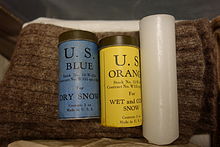Ski wax

Vintage ski waxes, once used by U.S. Army ski troops. Left to right are: grip waxes in canisters (blue for "dry snow" and yellow for "wet and corn snow") and a paraffin glide wax.
|
|
| Industrial sector(s) | Winter sports equipment and supplies |
|---|---|
| Main technologies or sub-processes | Tribology |
| Feedstock | Paraffin wax, resins, fluorocarbons |
| Product(s) | Glide wax, grip wax |
| Leading companies | Briko-Maplus, Dakine, Dominator, Hertel Wax, Holmenkol, Oneball, Purl, Rode, Swix, Toko, Visti (Висти) |
Ski wax is a material applied to the bottom of snow runners, including skis, snowboards, and toboggans, to improve their coefficient of friction performance under varying snow conditions. The two main types of wax used on skis are glide waxes and grip waxes. They address kinetic friction—to be minimized with a glide wax—and static friction—to be achieved with a grip wax. Both types of wax are designed to be matched with the varying properties of snow, including crystal type and size, and moisture content of the snow surface, which vary with temperature and the temperature history of the snow. Glide wax is selected to minimize sliding friction for both alpine and cross-country skiing. Grip wax (also called "kick wax") provides on-snow traction for cross-country skiers, as they stride forward using classic technique.
Modern plastic materials (e.g. high-modulus polyethylene and Teflon), used on ski bases, have excellent gliding properties on snow, which in many circumstances diminish the added value of a glide wax. Likewise, uni-directional textures (e.g. fish scale or micro-scale hairs) underfoot on cross-country skis can offer a practical substitute for grip wax for those skiers, using the classic technique.
Johannes Scheffer in Argentoratensis Lapponiæ (History of Lapland) in 1673 gave what is probably the first recorded instruction for ski wax application He advised skiers to use pine tar pitch and rosin. Ski waxing was also documented in 1761.
Beginning around 1854, California gold rush miners held organized downhill ski races. They also discovered that bases smeared with dopes brewed from vegetable and/or animal compound helped increase skiing speeds. This led to some of the first commercial ski wax (even though they contained no wax at all), such as Black Dope and Sierra Lighting; both were mainly composed of sperm oil, vegetable oil and pine pitch. However, some instead used paraffin candle wax that melted onto ski bases, and these worked better under colder conditions.
...
Wikipedia
